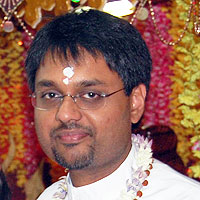From a satsang with Pt. Dr. Umesh Persad, Spiritual Leader, SWAHA Gyaan Deepak Kirtan Mandali
In Sanaatan Dharma, all religious rituals and practices possess deep philosophical meaning. As we advance along the spiritual path, it is important that we search for the innermost and highest essence of these rituals and practices. In spiritual practice, we begin with the physical actions of rituals, which serve as forms of purification. Then we proceed to the mental level, where the physical actions possess an inner meaning and also help to concentrate the mind, guiding it to a one-pointed state. There is also a level above that, which is beyond the mind, the Supreme Spirit. In this context, ‘beyond’ does not mean ‘separate from’; it means at its most essential level. Our scriptures teach us that the Divine is like ghee in milk, meaning it is the essence of everything; it is always there, beyond its look, taste and smell.
Yoga Vasistha tells of the gold cup. One can say that a cup is made of gold but not that the gold is made of cup; one is elemental to the other. In everything we see around us, physical and non-physical, there is one substance that is the basis of everything, which always exists. It is the Cause, which in Sanaatan Dharma, we call Brahm. The various divine forms pertain to various principles of action of the one Brahm.
In the Vigyaan Bhairav Tantra, Bhagavan Shankar and Parvati Devi talk about the highest meaning of religious activities. In that Brahm, referred to as Bhairav in Shaivism, even the highest void is dissolved along with the five senses and the mind, which is the ongoing process of thoughts. In fact, when the yogis investigate the mind, they realise that it does not exist as an entity on its own as it too is capable of dissolving. Havan is a significant religious ritual in Hinduism; the highest meaning of havan is the offering of the elements around us, the five senses and the mind with the ladle into the fire of Brahm. As the Srimad Bhagavad Gita, chapter 4, v. 24 states: “In the practice of seeing Brahm everywhere as a form of sacrifice, Brahm is the ladle (with which the oblation is poured into the fire); Brahm, again, is the oblation; Brahm is the fire; Brahm itself is the sacrifice and so Brahm itself constitutes the act of pouring the oblation into the fire. And finally, Brahm is the goal to be reached by him who is absorbed in Brahm as an act of such sacrifice.”
Similarly, the true act of pilgrimage is the absorption of the individual soul into the Divine. Jap is the contemplation of the highest reality. Dhyaan, meditation, has been interpreted as the unswerving intellect, buddhi. Puja is the fixation of the mind on that highest reality. The fulfilment that we seek is already within us in our true spiritual consciousness, which is who we truly are. The many religious rituals and practices, if viewed from the perspective of their highest meaning, will lead us to that state of spiritual fulfilment, the one consciousness of the Divine.



